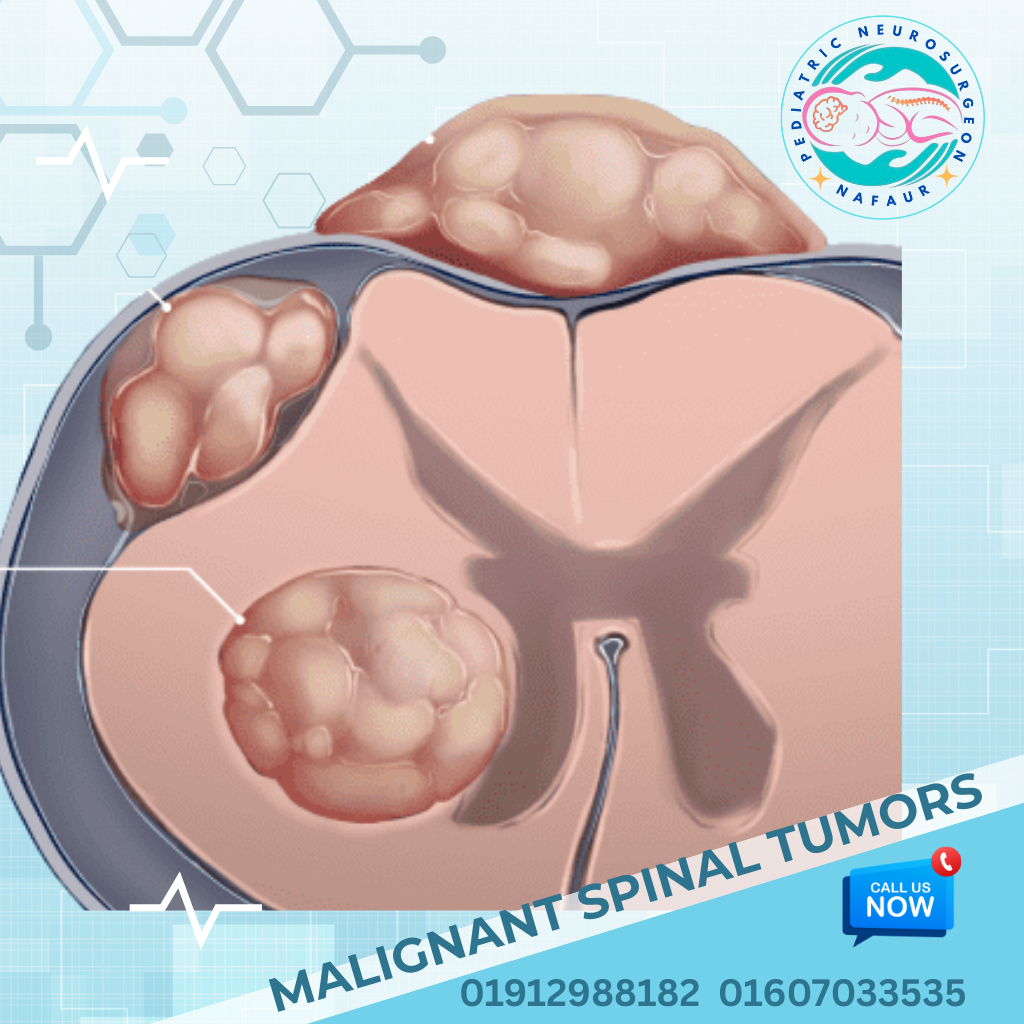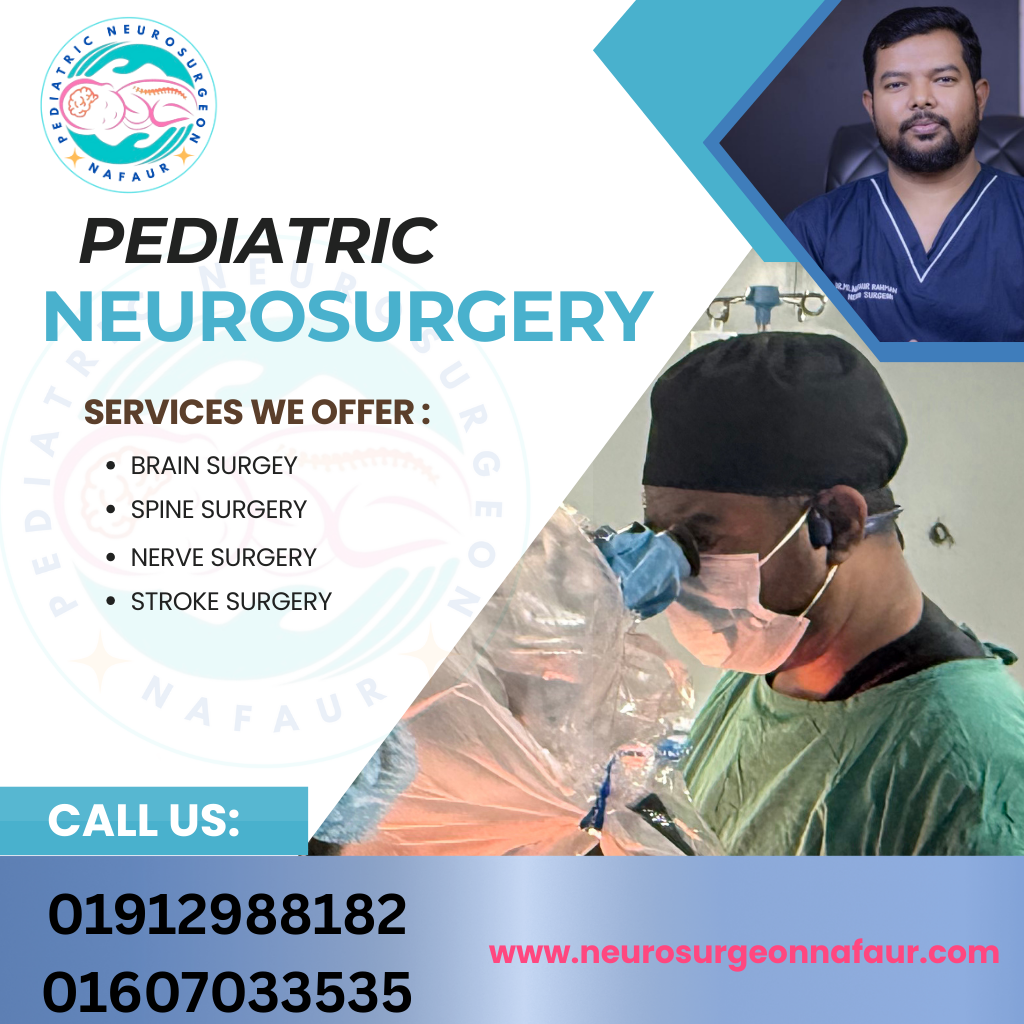Malignant Spinal Tumors
Pediatric malignant spinal tumors are rare but aggressive cancers that originate within or around the spinal cord, vertebrae, or spinal nerves in children. Unlike benign tumors, these malignant neoplasms have a high potential for local invasion, neurological damage, and metastasis. Early diagnosis and prompt multidisciplinary management are crucial for survival and quality of life.
In Bangladesh, many cases of pediatric spinal cancer are either misdiagnosed, referred late, or inadequately managed due to the shortage of specialized pediatric neurosurgical services and oncology resources. Under the expert care of Dr. Md. Nafaur Rahman, patients now have access to world-class spinal tumor care at NINS and Bangladesh Paediatric Neurocare Centre, with integrated support from neuro-oncology and rehabilitation teams.
 Common Types of Malignant Spinal Tumors in Children
Malignant spinal tumors in children can arise from different anatomical compartments:
1. Primary Intramedullary Tumors (inside the spinal cord):
High-grade astrocytomas
Ependymomas (anaplastic subtype)
2. Extradural/Vertebral Tumors (from bone or surrounding tissue):
Ewing’s Sarcoma – The most common malignant bone tumor in the spine
Osteosarcoma – May affect vertebral bodies
Chordomas – Rare tumors at the sacrum or skull base
Lymphoma or Leukemic Infiltration – Especially in immunocompromised children
3. Metastatic Spinal Tumors:
Spread from neuroblastoma, leukemia, or Wilms’ tumor
These tumors often present late, and due to the spine's confined space, they can cause rapid neurological deterioration.
Common Types of Malignant Spinal Tumors in Children
Malignant spinal tumors in children can arise from different anatomical compartments:
1. Primary Intramedullary Tumors (inside the spinal cord):
High-grade astrocytomas
Ependymomas (anaplastic subtype)
2. Extradural/Vertebral Tumors (from bone or surrounding tissue):
Ewing’s Sarcoma – The most common malignant bone tumor in the spine
Osteosarcoma – May affect vertebral bodies
Chordomas – Rare tumors at the sacrum or skull base
Lymphoma or Leukemic Infiltration – Especially in immunocompromised children
3. Metastatic Spinal Tumors:
Spread from neuroblastoma, leukemia, or Wilms’ tumor
These tumors often present late, and due to the spine's confined space, they can cause rapid neurological deterioration.
 Warning Signs & Symptoms
Malignant spinal tumors often present subtly, mimicking benign conditions. Warning symptoms include:
Persistent or severe back pain, often worse at night
Sudden-onset limb weakness or paralysis
Changes in walking pattern, unsteady gait
Loss of bladder or bowel control
Spinal deformity or scoliosis
Systemic signs like weight loss, fever, or fatigue
Palpable spinal or paraspinal mass
In Bangladesh, these signs are frequently misinterpreted as orthopedic issues, delaying neurosurgical referral and reducing survival chances.
Warning Signs & Symptoms
Malignant spinal tumors often present subtly, mimicking benign conditions. Warning symptoms include:
Persistent or severe back pain, often worse at night
Sudden-onset limb weakness or paralysis
Changes in walking pattern, unsteady gait
Loss of bladder or bowel control
Spinal deformity or scoliosis
Systemic signs like weight loss, fever, or fatigue
Palpable spinal or paraspinal mass
In Bangladesh, these signs are frequently misinterpreted as orthopedic issues, delaying neurosurgical referral and reducing survival chances.
 Diagnostic Protocol
At Dr. Nafaur Rahman’s centers, children with suspected spinal tumors undergo a rapid and structured diagnostic evaluation:
MRI of the entire spine with contrast – Detects tumor size, location, cord compression
CT Scan of the Spine – For bone involvement
Spinal and bone marrow biopsy – For histopathological confirmation
PET-CT or bone scan – To evaluate metastasis
CSF cytology – For tumors involving the spinal leptomeninges
Blood tests & tumor markers – Including LDH, AFP, and NSE
Genetic & immunohistochemistry studies – Especially in Ewing’s sarcoma and lymphoma
Fast-track diagnostics at NINS and BP Neurocare Centre minimize delay and allow early treatment initiation.
Diagnostic Protocol
At Dr. Nafaur Rahman’s centers, children with suspected spinal tumors undergo a rapid and structured diagnostic evaluation:
MRI of the entire spine with contrast – Detects tumor size, location, cord compression
CT Scan of the Spine – For bone involvement
Spinal and bone marrow biopsy – For histopathological confirmation
PET-CT or bone scan – To evaluate metastasis
CSF cytology – For tumors involving the spinal leptomeninges
Blood tests & tumor markers – Including LDH, AFP, and NSE
Genetic & immunohistochemistry studies – Especially in Ewing’s sarcoma and lymphoma
Fast-track diagnostics at NINS and BP Neurocare Centre minimize delay and allow early treatment initiation.
 Surgical Management
Surgery plays a key role in diagnosis, decompression, and tumor control, even in malignant cases. Dr. Md. Nafaur Rahman leads a skilled neurosurgical team trained in microsurgical spinal tumor removal with modern intraoperative techniques.
Surgical Goals:
Decompression of spinal cord to prevent paralysis
Maximal safe resection of tumor
Tissue diagnosis (biopsy or excisional)
Spinal stabilization or reconstruction, when vertebral bodies are involved
Surgical Techniques:
Laminectomy or laminoplasty
Microsurgical tumor resection using high-powered operating microscope
Intraoperative neuro-monitoring to protect spinal nerves
Spinal instrumentation and fusion for stability after tumor removal
Multidisciplinary collaboration with pediatric oncologists for intraoperative decision-making
“In pediatric spinal oncology, surgery is not only about removing the tumor—it’s about preserving mobility, preventing deformity, and improving long-term survival.”
— Dr. Md. Nafaur Rahman
Surgical Management
Surgery plays a key role in diagnosis, decompression, and tumor control, even in malignant cases. Dr. Md. Nafaur Rahman leads a skilled neurosurgical team trained in microsurgical spinal tumor removal with modern intraoperative techniques.
Surgical Goals:
Decompression of spinal cord to prevent paralysis
Maximal safe resection of tumor
Tissue diagnosis (biopsy or excisional)
Spinal stabilization or reconstruction, when vertebral bodies are involved
Surgical Techniques:
Laminectomy or laminoplasty
Microsurgical tumor resection using high-powered operating microscope
Intraoperative neuro-monitoring to protect spinal nerves
Spinal instrumentation and fusion for stability after tumor removal
Multidisciplinary collaboration with pediatric oncologists for intraoperative decision-making
“In pediatric spinal oncology, surgery is not only about removing the tumor—it’s about preserving mobility, preventing deformity, and improving long-term survival.”
— Dr. Md. Nafaur Rahman
 Oncological Treatment & Rehabilitation
Following surgery, most children with malignant spinal tumors require multi-modality treatment to improve outcomes and prevent recurrence.
Comprehensive Treatment Plan:
Chemotherapy – Based on tumor type (e.g., Ewing’s sarcoma protocols)
Radiotherapy – Conformal or proton therapy to reduce cord toxicity
Targeted therapy and immunotherapy – In eligible cases
Rehabilitation – Physical therapy, occupational therapy, neuro-rehabilitation
Psychosocial support – Counseling for child and parents
All adjuvant therapies are coordinated by a dedicated pediatric neuro-oncology team in collaboration with NINS and private cancer centers.
Oncological Treatment & Rehabilitation
Following surgery, most children with malignant spinal tumors require multi-modality treatment to improve outcomes and prevent recurrence.
Comprehensive Treatment Plan:
Chemotherapy – Based on tumor type (e.g., Ewing’s sarcoma protocols)
Radiotherapy – Conformal or proton therapy to reduce cord toxicity
Targeted therapy and immunotherapy – In eligible cases
Rehabilitation – Physical therapy, occupational therapy, neuro-rehabilitation
Psychosocial support – Counseling for child and parents
All adjuvant therapies are coordinated by a dedicated pediatric neuro-oncology team in collaboration with NINS and private cancer centers.
 Bangladesh Context: Unique Challenges and Solutions
Managing pediatric malignant spinal tumors in Bangladesh poses several challenges:
Common Issues:
Low awareness among primary care and orthopedic doctors
Financial barriers to MRI and histopathology
**Lack of pediatric oncology support in remote areas
Cultural stigma surrounding cancer diagnosis and spinal surgery
Dr. Nafaur Rahman’s Commitment:
Offers free consultation camps and early referral pathways
Works to raise awareness among pediatricians, neurologists, and school health programs
Leads interdisciplinary tumor boards for difficult cases
Connects patients to financial aid and support organizations
Bangladesh Context: Unique Challenges and Solutions
Managing pediatric malignant spinal tumors in Bangladesh poses several challenges:
Common Issues:
Low awareness among primary care and orthopedic doctors
Financial barriers to MRI and histopathology
**Lack of pediatric oncology support in remote areas
Cultural stigma surrounding cancer diagnosis and spinal surgery
Dr. Nafaur Rahman’s Commitment:
Offers free consultation camps and early referral pathways
Works to raise awareness among pediatricians, neurologists, and school health programs
Leads interdisciplinary tumor boards for difficult cases
Connects patients to financial aid and support organizations
 Why Trust Dr. Md. Nafaur Rahman?
Why Trust Dr. Md. Nafaur Rahman?
 One of the leading pediatric neurosurgeons in Bangladesh
One of the leading pediatric neurosurgeons in Bangladesh
 Based at NINS, the country’s premier neurosurgical institute
Based at NINS, the country’s premier neurosurgical institute
 Expert in complex spinal tumor surgeries in children
Expert in complex spinal tumor surgeries in children
 Utilizes intraoperative monitoring and advanced surgical tools
Utilizes intraoperative monitoring and advanced surgical tools
 Works closely with pediatric oncologists, pathologists, and rehab therapists
Works closely with pediatric oncologists, pathologists, and rehab therapists
 Delivers evidence-based care with empathy and precision
Delivers evidence-based care with empathy and precision
 Contact for Pediatric Spinal Tumor Evaluation
Dr. Md. Nafaur Rahman
Assistant Professor, Pediatric Neurosurgery, NINS
Chief Consultant, Bangladesh Paediatric Neurocare Centre
Contact for Pediatric Spinal Tumor Evaluation
Dr. Md. Nafaur Rahman
Assistant Professor, Pediatric Neurosurgery, NINS
Chief Consultant, Bangladesh Paediatric Neurocare Centre
 For Serial/Appointment: 01912988182 | 01607033535
For Serial/Appointment: 01912988182 | 01607033535
 Website: www.neurosurgeonnafaur.com
Website: www.neurosurgeonnafaur.com


























